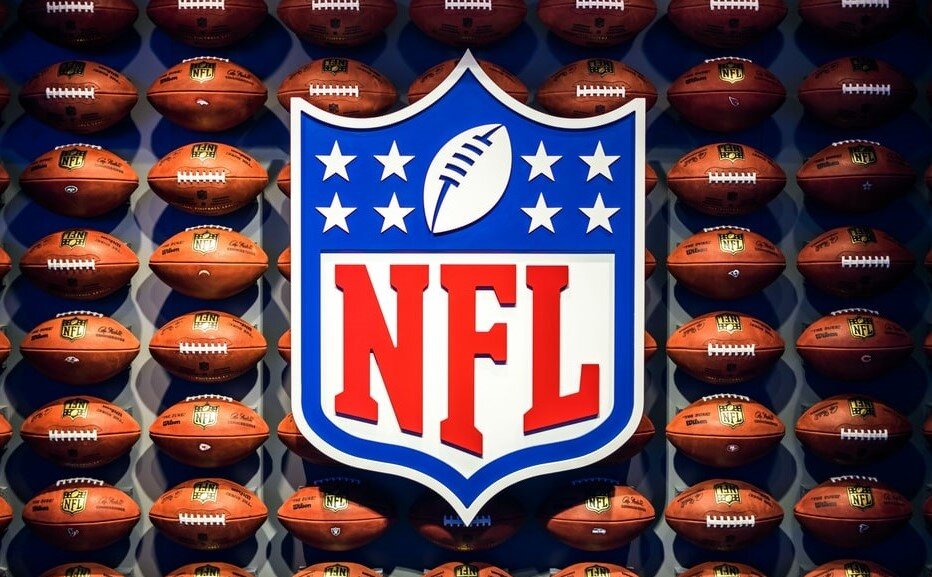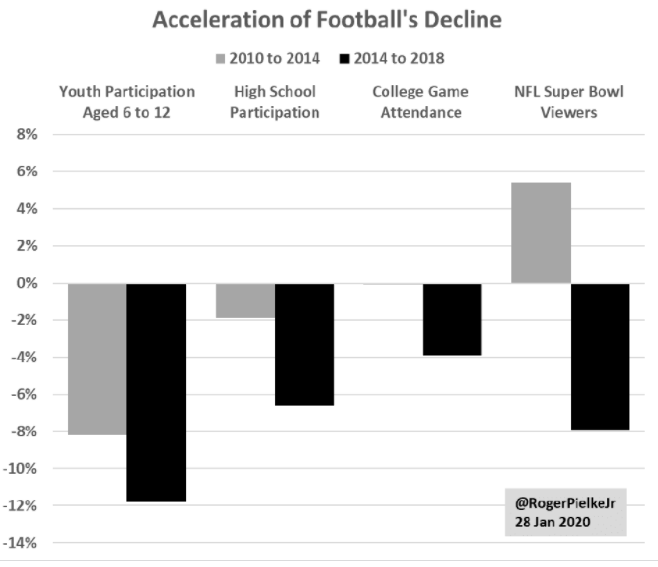
Ask any NFL or fantasy football fan, and they will tell you that injuries are still a routine part of the game. The NFL’s most prolific player, Derrick Henry, was recently placed on injured reserve with a broken foot, and Christian McCaffrey has missed the majority of the season with a leg injury of his own. Football is a violent sport, and violence necessarily leads to injuries, especially at the highest level of competition. In 2005, Doctor Bennet Omaul is credited with discovering Chronic Traumatic Encephalopathy (CTE) in former football players, a degenerative brain disease attributed to repeat head trauma. The 2015 film Concussion, starring Will Smith, raised awareness on the issue, as did lab results that found the presence of CTE in the brains of former NFL players who committed suicide (e.g. Junior Seau and Aaron Hernandez). In recent years, the NFL has implemented a number of changes to make the game less dangerous and safeguard football’s status as America’s favorite sport. While there is still a lot we don’t know, it is abundantly clear that minimizing impact to the head is one surefire way to achieve this goal.

Some people hate the new, “softer” NFL (relatively to an exceptionally brutal previously era), but the new rules are here to stay, and more changes are likely to follow as data trickles in. To be sure, I’m not suggesting that football is now safe, nor am I saying that anyone should play it or watch it. What I am presenting are 7 more or less objective reasons why the NFL might be safer today than at any other point in the past. Without further ado. . .
7 Reasons The NFL Today Is Safer Than Ever
#1. Contact Rule Changes In Practice
There are now 17 games in an NFL season, not counting the playoffs. Practice, however, happens year-round. Players used to routinely hit each other hard in practice in order to prepare for in-game competition. After all, how do you get better at tackling without tackling? NFL practices today are more a simulation of in-game contact. They use tackling dummies and work on skills that translate to the game, but hard hitting is typically reserved for the game itself. I put this one as #1 for a reason. I think contact rule changes in practice is the single biggest change that has made the NFL safer due to the sheer volume of practice repetitions.
#2. Expansion Of Concussion Protocol
A few years ago, the NFL implemented concussion protocol to keep players who had just suffered a concussion off the field. The NFL hired professionals on the sideline at each game whose job is to identify potential head trauma and ensure that affected players go through proper health protocols, whether or not they want to voluntarily leave the game. Concussions in the past were referred to as “stingers,” or a “player getting his bell rung.” Oftentimes, players would re-enter the game or practice before their injury had time to heal. This put them at a much higher risk of getting a second concussion and suffering permanent brain damage.
“Second impact syndrome” is the most extreme example of this risk, upon which multiple concussions in a row can lead to death or severe brain damage. Concussion protocol is far from perfect, but keeping concussed players off the field in order to heal has been a huge step in the right direction.
#3. Advances In Helmet Technology
The NFL is constantly researching padding technology to reduce the incidence and severity of all injuries, with head injuries being foremost on the agenda. In 2018, the NFL and NFL Player’s Association agreed to ban 10 helmet models that yielded poor results in safety studies that simulated in-game impact. According to NFL.com (here), 200 players in 2017 wore helmets that are now banned, and so this measure has been another big step toward greater player safety.
#4. Contact Rule Changes In The Game
#4 has likely generated the most controversy. Replay has eliminated a lot of the human error in NFL officiating, but some fans are unhappy with the frequency of unnecessary roughness and helmet-to-helmet penalties that have been called in recent years. These changes have come as a part of the NFL’s overall effort to reduce the incidence of head trauma.
For example, you can’t lower the head to initiate helmet-to-helmet contact, a tactic that was commonplace in the old NFL. You can’t blow up defenseless players without the ball haplessly making their way down the field. You can’t tackle quarterbacks low, throw your weight on them too hard, or otherwise use force that is deemed unnecessary. Players have largely made the adjustment, and the quantity of hits like these has decreased substantially. However, there is still not an NFL game in which multiple players do not violate these rules, which goes to show just how much awareness and caution is necessary to comply.
#5. An Increased Percentage Of Touchbacks On Kickoffs
Kickoffs relatively account for more concussions than any other play in football. According to WebMD, one college study in 2015 found that kick-offs accounted for 21% of concussions, but only made up 6% of plays. The NFL did its own study, WebMD reports, which found that concussions were five times more likely to occur on kick-offs than on any other play. This is hardly surprising. On the kick-off, you have 11 grown men sprinting into 11 other grown men, all with malicious intentions.
The NFL has since changed kick-off rules in the interest of player safety. Kickers now kick-off 5 yards closer to the opposing end-zone to allow for more touchbacks, where no return is made and the receiving team starts their possession from a predetermined position on the field. The NFL also moved the predetermined position up 5 yards, which further disadvantages return teams from taking the ball out of the end zone. In addition, players on the kicking team no longer get a running start, and kicking teams cannot use bunch packages designed to isolate (and, effectively endanger) returners.
In 2003, 7.3% kick-offs ended in a touchback, whereas the record-setting figure in 2020 was 61.2% (source), evidencing that this routine aspect of the game is a lot less a problem than before. Kick-offs, which take place at the beginning of halves and after points are scored, are now largely ceremonial.
#6. A Reduction In Design Run Plays
Running plays, I reason, are somewhat more dangerous than passing plays. On a design run play, you have 11 guys collapsing on 11 guys to bring a ball carrier to the ground. Everyone on the field is engaged in physicality. On a pass play, in contrast, there are typically four or five receivers, including the running back and tight end. Many pass plays end without receivers and defenders in the secondary experiencing any contact at all (it’s illegal to make too much contact with a receiver down the field). On completed passes, the receiver is typically brought down quickly by one or two defenders, runs out of bounds, or dives to the ground, in order to avoid a major hit.
Running is still important for tactical reasons and short yardage situations, but passing has become a much more efficient way to move the ball. As a result, NFL has witnessed a steady decline in the % of run plays over the last several years. Passing plays currently average around 7 yards per attempt, whereas run plays clock in at a little above 4 yards per carry. In the early 2000s, the median % of pass plays per team was around 55%; now it is closer to 60% (source). However, the difference is much larger if you take into account “design run plays,” versus “design pass plays.” There are way more quarterbacks today who scramble than there were in past years. A lot of the “run plays” in the statistics were actually design pass plays on which the quarterback ended up taking off. Quarterbacks, physically weaker, more fragile, and more important to the team’s success than running backs, are notorious for sliding or running out of bounds to avoid contact. Unlike the average design run play, there is often no impact on quarterback scrambles.
#6 doesn’t get talked about a lot, but I think it has made measurable impact on the safety of the game.
7. New NFL Cultural Sensitivity To Head Trauma
The NFL is a fraternity. With a few notable outliers (Vontaze Burfict?), players have each others back. As ruthlessly competitive as they are, most players do not wish to physically injure their opponent. Players also know that the NFL is an iterated game. That means that you play teams more than once over the course of a career, and sometimes more than once in the same season. What goes around comes around, and how you treat others is typically how they are going to treat you.
As a result, I think you’re seeing players take more measures to protect heads, as much as possible. That means not lowering your head to tackle the opponent, which protects both the offensive and defensive party. I also see a lot of ball carriers going out of bounds or diving forward instead of absorbing contact. I don’t remember exactly how it was in the past, but it seems that players today are a lot quicker to shun contact, especially when they can achieve a similar result by giving themselves up early.
Getting tackled can also be a tactical disadvantage, because it makes a ball carrier a lot more likely to fumble. It’s often not worth absorbing a big blow just to gain a yard or two, unless the end zone or first down is within reach. . .
That’s all I got for this one! Let me know what I left out in the comments.
If you liked this post, check out [display-posts id=”488″ image_size=”thumbnail”]

[…] has been linked to a host of medical issues, including chronic traumatic encephalopathy (CTE) (See NFL safety changes). A number of studies have identified a relationship between neck strength and the incidence of […]